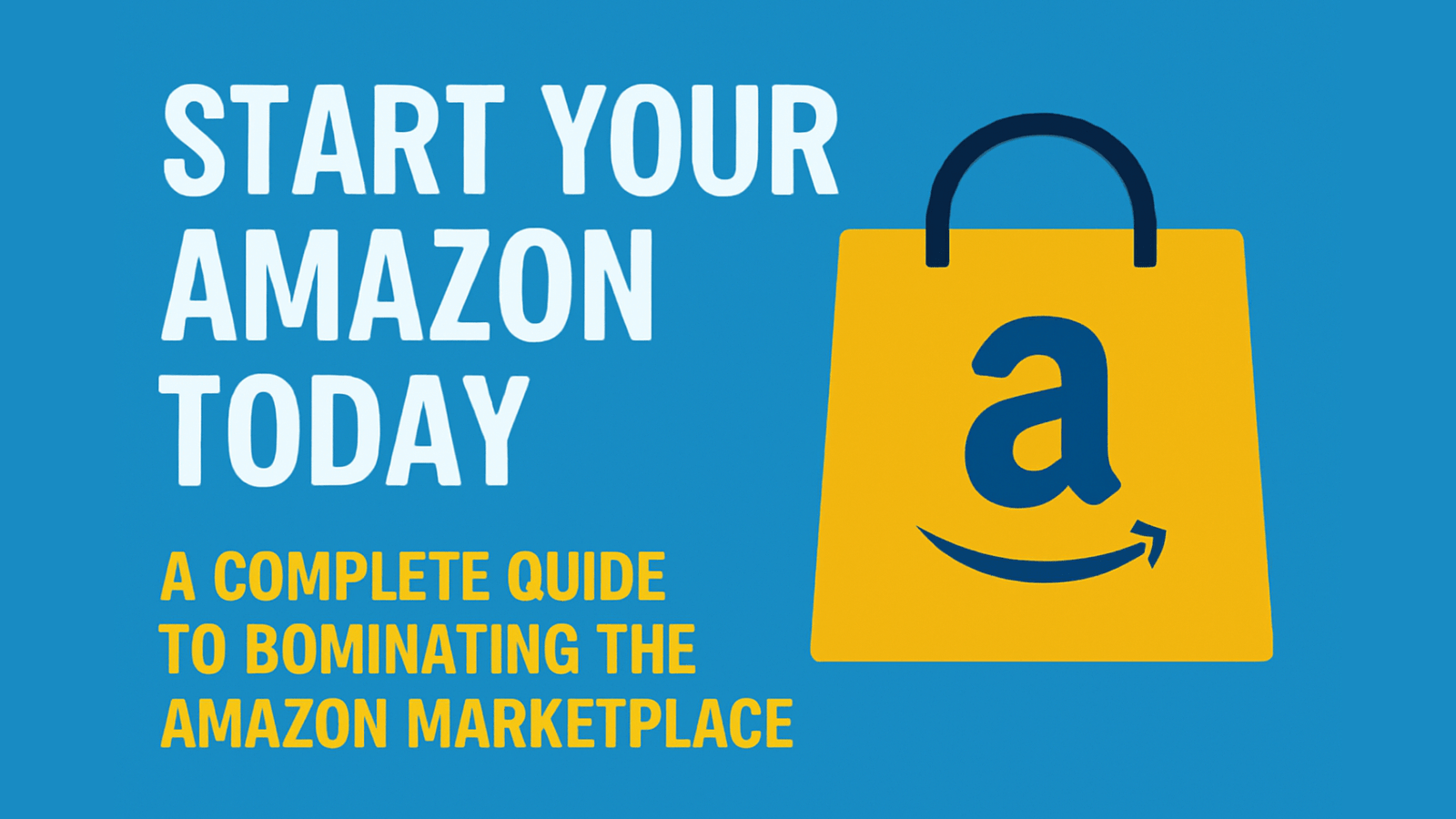Are you thinking about starting an online business? Or maybe you already have a product and want to break into one of the largest eCommerce platforms in the world? Look no further than Amazon. As the Amazon Marketplace continues to expand, there’s never been a better time to dive into the world of online selling. Whether you’re looking into Amazon Wholesale, Amazon Private Label, or simply optimizing your listings for better sales, this guide will provide you with everything you need to know.
In this article, we’ll cover Amazon SEO tips, strategies for Amazon listing optimization, the intricacies of the Amazon A10 algorithm, and how to best use Amazon backend keywords for the ultimate sales boost. You’ll walk away with a comprehensive roadmap to get your eCommerce Amazon USA business running smoothly, whether you’re a newbie or an experienced seller. Let’s get started!
Why Start Your Amazon Today?
Amazon is the king of online marketplaces, and its influence continues to grow. If you’re thinking of venturing into online selling, Amazon offers the potential for exponential growth. From Amazon Wholesale and Amazon Private Label to selling in bulk or creating your own brand, there’s no limit to the possibilities.
With over 300 million active customer accounts worldwide, Amazon provides an audience you simply can’t find anywhere else. Whether you’re a first-time seller or have years of experience, Amazon’s tools and resources, such as Amazon Seller Central and Amazon FBA, make starting your business easier than ever before.
Understanding the Amazon Marketplace
Before diving into selling on Amazon, it’s essential to understand the Amazon Marketplace. Think of it as a digital mall where sellers and buyers meet. While Amazon sells products directly, third-party sellers also use the platform to reach a global audience.
Amazon’s Marketplace is divided into several categories, such as Amazon FBA, which allows sellers to store their products in Amazon’s fulfillment centers, and Amazon Private Label, where you can create your own branded products. Understanding the differences will help you decide which route best suits your business.
How Amazon Works: A Quick Overview
Amazon Seller Central is the hub for sellers to manage their products, track sales, and get access to powerful tools for improving their Amazon listings. Whether you’re using Amazon FBA or handling shipping yourself, your seller account will be the backbone of your business.
Here’s a brief breakdown of how Amazon works:
- Create an Amazon Seller Account: Choose between individual or professional plans.
- List Your Products: Create product listings, including titles, descriptions, and images.
- Optimize Listings: Use Amazon’s tools and tips to optimize your listing for higher rankings.
- Fulfill Orders: Use Amazon FBA for storage and shipping, or fulfill orders yourself.
Amazon SEO Tips for Beginners
One of the keys to success in Amazon online selling is mastering Amazon SEO. In a crowded marketplace, it’s essential to make sure your products are visible. Amazon uses an algorithm, called the Amazon A10 algorithm, to rank listings based on various factors like keywords, sales performance, and customer reviews.
Here are some powerful Amazon SEO tips to help your listings get noticed:
- Use Relevant Keywords: Integrate the most popular and relevant keywords into your listings.
- Focus on Amazon’s Search Engine: Amazon’s search engine (A10) rewards relevancy, so make sure your listings are keyword-optimized for better visibility.
- Regularly Update Listings: Amazon values fresh, up-to-date content, so don’t forget to revisit your listings and update them regularly.
- Use High-Quality Images: Make sure your product images are clear and professional. You want your product to stand out in search results.
Also read this: Amazon FBA Guide
Amazon Listing Optimization: The Key to Sales
In the Amazon Marketplace, standing out from the competition is vital. Optimizing your listings is one of the most effective ways to do this. Amazon listing optimization involves improving your product titles, descriptions, bullet points, and backend keywords. Let’s break down some of the key elements of an optimized listing.
1. Amazon Product Title Optimization
Your Amazon product title is the first thing a customer sees, and it can make or break a sale. It’s important to follow Amazon’s title guidelines to maximize visibility and click-through rate (CTR).
- Keep It Simple but Detailed: Include relevant product details such as size, color, and brand.
- Use Primary Keywords: Incorporate high-traffic keywords while keeping the title readable.
- Follow Amazon’s Rules: Titles that are too long or contain excessive punctuation can be penalized by Amazon.
2. Amazon Bullet Points Best Practices
Bullet points are an excellent way to highlight the most important features of your product. Here are some tips:
- Highlight Unique Features: Focus on what makes your product special or different from others.
- Use Keywords: Sprinkle relevant keywords in your bullet points.
- Answer Common Customer Questions: Preemptively address concerns or inquiries that customers may have.
Amazon Backend Keywords Guide: Hidden Gems for SEO
When creating an Amazon listing, you also have the opportunity to add backend keywords. These are hidden search terms that can improve your listing’s discoverability. Using Amazon backend keywords best practices can make a huge difference in driving traffic to your listing.
Here are some backend keyword tips:
- Avoid Keyword Stuffing: Don’t use irrelevant or repetitive keywords in your backend fields.
- Use All Available Space: Amazon allows a specific character limit for backend keywords. Make sure you use every bit of it.
- Focus on Synonyms and Misspellings: Include potential variations of your keywords that shoppers may use.
Also read this: Best Amazon Seller Tools for FBA
Best Amazon Seller Tools to Streamline Your Business
To get the most out of Amazon Seller Central, there are plenty of third-party tools designed to help you streamline your operations. Here are some of the best Amazon seller tools to consider:
- Jungle Scout: This tool offers in-depth market research and keyword tracking features.
- Helium 10: A comprehensive suite for keyword research, listing optimization, and Amazon product tracking.
- AMZScout: A great tool for tracking product performance and market trends.
These tools will help you with Amazon product title optimization, listing optimization, and so much more, making your seller experience smoother and more efficient.
How to Optimize Your Amazon Listings
If you want to ensure your Amazon listings stand out and rank high, you need to focus on a few core areas:
- Title: Make sure it’s both descriptive and optimized with keywords.
- Description: Use this space to tell your brand story and answer any lingering questions.
- Images: High-quality images are critical to gaining trust from potential customers.
- Reviews: Positive customer reviews will help you build credibility and improve your ranking.
The Amazon FBA Guide: Streamline Your Business
Fulfillment by Amazon (FBA) is one of the most powerful features for sellers. It allows you to store your products in Amazon’s warehouses, and they take care of the packing, shipping, and customer service. Here’s a quick guide to Amazon FBA:
- Inventory Storage: Ship your products to Amazon’s warehouse, and they handle the rest.
- Shipping & Handling: Amazon takes care of order fulfillment and delivery, which can lead to faster shipping times and more satisfied customers.
- Customer Support: Amazon’s customer service team handles returns, refunds, and questions.
Amazon Seller Central Tutorial: Getting Started
For new sellers, Amazon Seller Central can seem overwhelming. But once you familiarize yourself with the platform, you’ll be ready to take on the Amazon Marketplace with confidence. Here’s a simple tutorial to get you started:
- Set Up Your Account: Choose your selling plan and complete the registration process.
- Create Listings: Add your product details, including title, price, and images.
- Optimize Listings: Use Amazon SEO tips and backend keywords to improve visibility.
- Manage Orders: Keep track of orders and ensure timely fulfillment.
- Track Sales: Use Amazon’s analytics to monitor your sales and optimize your strategy.
Conclusion: Starting Your Amazon Journey Today
There’s no time like the present to start your Amazon business. Whether you’re diving into Amazon Private Label, using Amazon Wholesale, or just trying to optimize your Amazon listings, the possibilities are endless. With the right tools, strategies, and knowledge of Amazon SEO, you’ll be on your way to building a successful business on one of the most robust e-commerce platforms in the world.
Starting Amazon today isn’t just about selling products; it’s about positioning yourself for long-term growth. So, get ready to hit the ground running and take advantage of Amazon’s incredible opportunities. Happy selling!
FAQs
- How do I start selling on Amazon?
Create an Amazon Seller account, choose your selling plan, and start listing your products. Optimize your listings with high-quality images, titles, and descriptions. - What is Amazon FBA?
Fulfillment by Amazon (FBA) is a service where Amazon stores your products, handles shipping, and manages customer service on your behalf. - What are backend keywords?
Backend keywords are hidden search terms you can add to your Amazon listings to improve discoverability without cluttering your product description. - How do I optimize my Amazon product listing?
Focus on clear, descriptive titles, engaging bullet points, high-quality images, and relevant keywords. - What is the A10 algorithm?
Amazon’s A10 algorithm is the system that ranks listings based on factors like relevance, sales performance, and customer satisfaction. - How can I improve my Amazon SEO?
Use high-ranking, relevant keywords in your titles, descriptions, and backend, and consistently update your listings to ensure they remain fresh and competitive.





